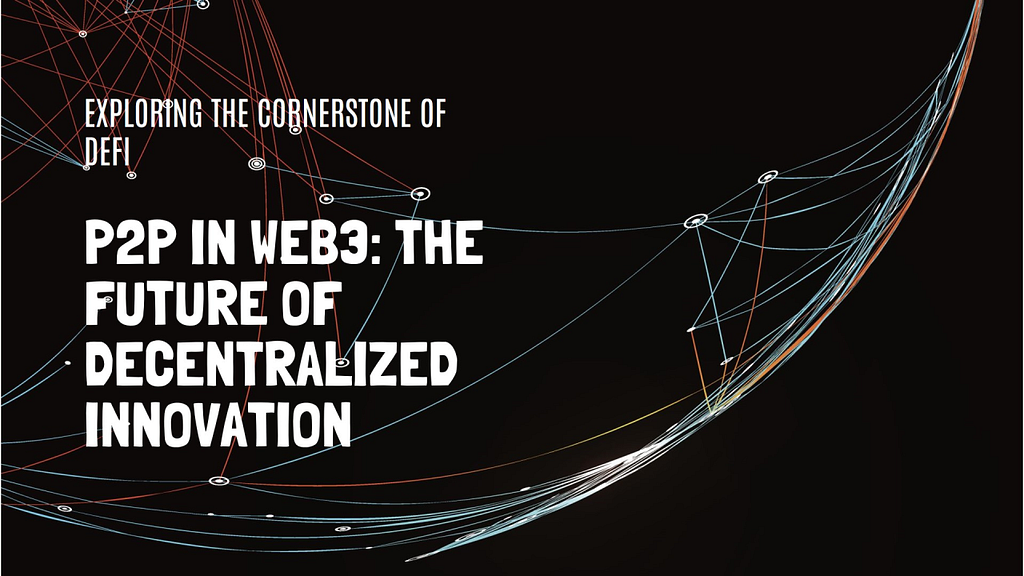P2P in Web3: The Cornerstone of Decentralized Innovation (DeFi)

As the blockchain ecosystem continues to evolve, one paradigm stands out as the linchpin of decentralized innovation: peer-to-peer (P2P) interactions.
In the Web3 era, P2P is not just a technical concept; it is the essence of decentralization, enabling trustless, cross-border and transparent transactions without intermediaries.
This article explores why P2P is the dominant use case in Web3, its transformative impact on cross-border payments in Africa, and offers practical guidance for developers looking to harness its potential through smart contracts on the Ethereum Virtual Machine (EVM).
The Legacy of P2P: From Bitcoin to Web3In 2008, Satoshi Nakamoto introduced Bitcoin through a seminal whitepaper, “Bitcoin: A Peer-to-Peer Electronic Cash System.
“ This paper laid the foundation for modern blockchain technology by presenting a decentralized, P2P system for transferring value without intermediaries. Nakamoto’s vision emphasized the importance of P2P interactions to achieve true decentralization and trustless transactions.
Today, this vision extends beyond Bitcoin, influencing the broader Web3 ecosystem.
Why P2P is the King in Web31. True Decentralization:
P2P interactions embody the core philosophy of blockchain: decentralization. By facilitating direct exchanges between parties, P2P systems eliminate the need for central authorities, reducing points of failure and censorship.
2. Enhanced Security:
With no central points of control, P2P networks are inherently more resilient to attacks. Transactions are secured by cryptographic protocols and consensus mechanisms, making it exceedingly difficult for malicious actors to manipulate the system.
3. Cost Efficiency:
By removing intermediaries, P2P systems can significantly reduce transaction costs. Users can transact directly, saving on fees that would otherwise go to third parties.
4. Empowering Users:
P2P networks empower individuals by giving them full control over their assets and data. This democratization of power aligns with the ethos of Web3, fostering a more inclusive digital economy.
P2P is solving Cross-Border Payment Problems in AfricaAfrica faces significant challenges with cross-border payments, including high transaction fees, lengthy processing times, and limited access to traditional banking services.
P2P solutions are poised to revolutionize this landscape by offering:
1. Lower Costs: Traditional cross-border payments often come with exorbitant fees.
P2P systems drastically reduce these costs by eliminating intermediaries, making international transactions more affordable for individuals and businesses alike.
2. Faster Transactions: Conventional banking systems can take days to process cross-border payments. P2P transactions on the blockchain can be completed in minutes, providing faster access to funds and improving liquidity.
3. Financial Inclusion: Many individuals in Africa lack access to traditional banking services. P2P solutions enable anyone with a smartphone and internet access to participate in the global economy, promoting financial inclusion and economic growth.
4. Transparency and Trust: Blockchain technology ensures transparency and immutability of transactions. This builds trust among users, as they can verify transactions independently, reducing the risk of fraud and corruption.
Building P2P Smart Contracts on EVMFor developers, leveraging P2P interactions through smart contracts on the EVM opens a world of possibilities.
Here’s a step-by-step guide to get you started:
1. Understand the Basics:
Before diving into coding, it’s crucial to have a solid understanding of Ethereum and its virtual machine. Familiarize yourself with Solidity, the primary programming language for writing smart contracts on Ethereum.
2. Set Up Your Development Environment:
Ensure you have the necessary tools installed, including a code editor (like Visual Studio Code), Node.js, and Truffle or Hardhat for smart contract development.
3. Writing Your First P2P Smart Contract:
Let’s create a simple escrow contract, a common P2P use case.// SPDX-License-Identifier: MITpragma solidity ^0.8.0;contract Escrow {
address public payer;
address public payee;
address public lawyer;
uint public amount; constructor(address _payer, address _payee, uint _amount) {
lawyer = msg.sender;
payer = _payer;
payee = _payee;
amount = _amount;
} function deposit() public payable {
require(msg.sender == payer, "Sender must be the payer");
require(address(this).balance <= amount, "Cannot send more than escrow amount");
} function release() public {
require(address(this).balance == amount, "Cannot release funds before full amount is sent");
require(msg.sender == lawyer, "Only lawyer can release funds");
payable(payee).transfer(amount);
} function balanceOf() view public returns (uint) {
return address(this).balance;
}
}
4. Testing Your Contract:
Deploy and test your contract on a local Ethereum network using Truffle or Hardhat.
Ensure all functions work as expected before deploying to a testnet or mainnet.
5. Deploying to a Network:
Once your contract is thoroughly tested, deploy it to a test network like Rinkeby or Ropsten. After successful testing on a testnet, you can deploy it to the Ethereum mainnet.
6. Security Considerations:
Security is paramount in P2P systems. Conduct thorough audits of your smart contracts, employ best practices to mitigate risks, and consider third-party audits for critical contracts.
ConclusionP2P interactions are the backbone of the Web3 revolution, enabling a truly decentralized, secure, and cost-efficient ecosystem.
By mastering the art of writing P2P smart contracts on EVM, developers can contribute to this transformative movement, building applications that are robust, transparent, and fair.

P2P in Web3: The Cornerstone of Decentralized Innovation (DeFi) was originally published in Coinmonks on Medium, where people are continuing the conversation by highlighting and responding to this story.
